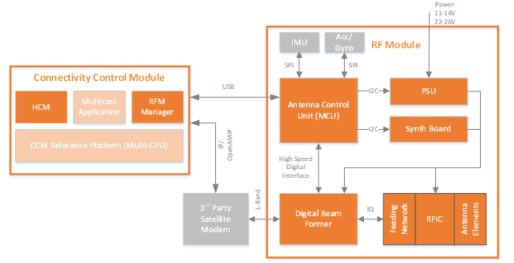
-
StatusOngoing
-
Status date2023-05-31
-
Activity Code7B.042
To energise the UK space sector supply chain and create ecosystems for the growth of the space sector, specifically in satellite technology for automotive applications. This is achievable through:
-
Bringing together technical elements, academic research, and supply chain.
-
Design, simulation, and validation of novel antenna, RFIC and RFM technologies.
-
Designing for manufacturing and assembly capability, with a goal of low-cost and high-volume manufacturability.
-
Tier-1 industry engagement.
In general, the R&D on Ka-band SATCOM terminal for LEO satellites in this project sits in a yet-to-exist commercial domain. This requires novel thinking, problem-solving with complex system design, and careful assumption management.
Technical challenges faced in this project:
-
IC industry slowing down during COVID-19; influencing the acceleration of the programme to a second technology iteration.
-
Integration conflicts due to limited fabricators capable of mounting the novel IC hardware – now significantly improved in our second design iteration.
-
Future challenge of ramping up to full-scale antenna array.
The primary benefit of the CASSIS terminal is the provision of constant connectivity to the user with seamless switching between satellite networks across different orbits. Future developments will enable switching between terrestrial and non-terrestrial networks. Through the use of the compact phased array antenna, the terminal is able to track and communicate with LEO, MEO and GEO satellites leveraging the latest DVB standards.
The low-profile antenna and small electronics assembly allows for integration with road vehicles, and the dual companion hotspot and standalone infotainment modes provide options for in-vehicle connectivity.
The CASSIS terminal consists of an RF Module and a Connectivity Control Module (CCM).
-
The RF Module comprises variable size flat panel phased array antennas for transmit and receive, an RFIC, a digital beamformer and an Antenna Control Unit. These are the key innovations and enablers of the RF subsystem and the benefits described above. The high-performance beam steering enabled by these components allows high throughput connectivity to be maintained while satellites are in view.
-
The CCM enables the switching between LEO and GEO satellite networks depending on signal strength, enabling constant connectivity for the vehicle while one of these options is available. The ability to interface with third party modems further enhances the flexibility of the terminal and increases resilience to external market changes by not relying on a single source provider.

Key components of the system architecture developed in CASSIS are highlighted orange.
Once the Technology phase is completed, the consortium will use the Prototype to engage with Tier-1 and OEMs to pursue an R&D relationship for the maturing of the CASSIS technology into a commercial product.
The consortium is working on the design and fabrication of the second design iteration RFM Reference Board Prototype, to integrate the second design iteration RFIC which has been successfully validated. Antenna measurements have been taken, which validate the design simulations. The consortium is shaping up opportunities for the continuation and exploitation of the CASSIS technologies proven so far.







